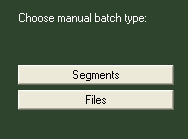Fully automated batch processing
This type of batch processing is run from the 'batch'-tab in the dynamic section of ANSLAB command window.
A number of checkboxes can be activated for the corresponding anaylsis types. These analysis types are run for
every file in the batch.
The list of files to be processed is specified by loading a batch file
(see
file menu and
preparing a batch analysis
for more details).
If a file in the batch is not found at the specified location, ANSLAB continues with the next file.

Usually the batch analysis is done file by file. But you may also choose to perform the analysis based
on segments by changing the batch type accordingly. In this case you must ensure that for each raw
file a timing file, specifiying the segments, is present.
Note: in case of accelerometry and marker analysis the presence of timing files
is ignored even if the batch type is set to 'segments'. Hence, in this case the complete files are analyzed at once.
[
Top]
Semi-automatic batch processing
This type of batch processing is similar to manual processing, except that a batch file must be loaded
beforehand and that instead of using the 'open data file(s)'-button, the 'next'- button is used for
starting the analysis.
You are prompted to select a type of batch processing with the dialog shown below:

This allows you to choose whether files should be processed as multiple segments
or as a whole. If you choose 'Segments', ANSLAB reads the associated timing file and processes the next segment
of the file, when you hit the next button. Once all segments have been processed, ANSLAB jumps to the next file.
If you choose 'Files', ANSLAB jumps directly to the next file in the batch.
Note that during the analysis of a file, you still have to use the 'resume'-button to advance in the processing steps, just like during manual
analysis. You can navigate through the files or segments, e.g. after changing settings in the options dialog or to skip bad data
files/segments, using the 'jump'- and 'back'-button in the dynamic section of the ANSLAB command window.
You can also jump to specific file/segments by entering a number in the edit-box on the right of these buttons. Whether
files or segments will be the navigation unit is set using the files/segments-dropdownlist.
To make processing even faster, the red-colored button on the command window (the default command at a certain point of an analysis) can
also be selected by hitting the "." (period) key on the keyboard.
[
Top]

